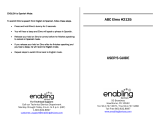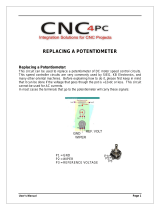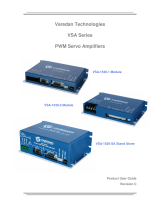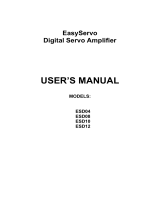Page is loading ...

Drum
Digital Servo Drive
Installation Guide
April 2008 (Ver. 1.0)

Notice
This guide is delivered subject to the following conditions and restrictions:
This guide contains proprietary information belonging to Elmo Motion Control Ltd.
Such information is supplied solely for the purpose of assisting users of the Drum
servo drive in its installation.
The text and graphics included in this manual are for the purpose of illustration and
reference only. The specifications on which they are based are subject to change
without notice.
Elmo Motion Control and the Elmo Motion Control logo are trademarks of Elmo
Motion Control Ltd.
Information in this document is subject to change without notice.
Document No. MAN-DRUIG
Copyright 2008
Elmo Motion Control Ltd.
All rights reserved
Drum Catalog
Number:
Maximum DC
Operating Voltage
Continuous Current
(Amps)
Version :
Blank = Standard
A=Advanced
Feedback:
Blank = Incremental
Encoder
and/or Halls
R=Resolver
DRU- AXX/YYYR
T = Tachometer &
Potentiometer
I = Interpolated
Analog
Encoder
Q=
Encoder
Absolute
Revision History:
Ver. 1.0 April 2008 Initial Release (
MAN-DRUIG.PDF)
Elmo Motion Control Ltd.
64 Gisin St., P.O. Box 463
Petach Tikva 49103
Israel
Tel: +972 (3) 929-2300
Fax: +972 (3) 929-2322
Elmo Motion Control Inc.
1 Park Drive, Suite 12
Westford, MA 01886
USA
Tel: +1 (978) 399-0034
Fax: +1 (978) 399-0035
Elmo Motion Control GmbH
Steinkirchring 1
D-78056, Villingen-Schwenningen
Germany
Tel: +49 (0) 7720-85 77 60
Fax: +49 (0) 7720-85 77 70
www.elmomc.com

Contents
Chapter 1: Safety Information........................................................................................1-1
1.1 Warnings..............................................................................................................1-2
1.2 Cautions...............................................................................................................1-2
1.3 Directives and Standards...................................................................................1-3
1.4 CE Mark Conformance.......................................................................................1-3
1.5 Warranty Information........................................................................................1-3
Chapter 2: Introduction....................................................................................................2-1
2.1 Drive Description................................................................................................2-1
2.2 Product Features.................................................................................................2-1
2.2.1 Current Control...........................................................................................2-1
2.2.2 Velocity Control...........................................................................................2-2
2.2.3 Position Control...........................................................................................2-2
2.2.4 Communication Options............................................................................2-2
2.2.5 Feedback Options........................................................................................2-2
2.2.6 Fault Protection............................................................................................2-3
2.3 System Architecture............................................................................................2-3
2.4 How to Use this Guide.......................................................................................2-4
Chapter 3: Installation......................................................................................................3-1
3.1 Before You Begin.................................................................................................3-1
3.1.1 Site Requirements........................................................................................3-1
3.1.2 Hardware Requirements............................................................................3-1
3.2 Unpacking the Drive Components ...................................................................3-3
3.3 Mounting the Drum............................................................................................3-4
3.4 Connecting the Cables........................................................................................3-5
3.4.1 Wiring the Drum.........................................................................................3-5
3.4.2 Connecting the Power Cables....................................................................3-8
3.4.2.1 Connecting the Motor Cable................................................................3-10
3.4.2.2 Connecting the DC Power....................................................................3-10
3.4.2.3 Connecting the Optional Back-up Supply Cable...............................3-13
3.4.3 Feedback Control and Communication Cable Assemblies.................3-14
3.4.4 Main Feedback Cable (FEEDBACK A)...................................................3-15
3.4.5 Main and Auxiliary Feedback Combinations .......................................3-28
3.4.6 Auxiliary Feedback (FEEDBACK B).......................................................3-29
3.4.6.1 Main Encoder Buffered Outputs or Emulated Encoder Outputs Option
on FEEDBACK B (YA[4]=4)...............................................................................3-30
3.4.6.2 Differential Auxiliary Encoder Input Option on FEEDBACK B
(YA[4]=2) ........................................................................................................3-32
3.4.6.3 Single-ended Auxiliary Input Option on FEEDBACK B (YA[4]=2).3-34
3.4.6.4 Pulse-and-Direction Input Option on FEEDBACK B (YA[4]=0)......3-36
3.4.7 I/O Cables..................................................................................................3-40
3.4.7.1 General I/O Port (J3)............................................................................3-40
3.4.8 Communication Cables............................................................................3-42
3.4.8.1 RS-232 Communication........................................................................3-42
3.4.8.2 CANopen Communication..................................................................3-43
3.5 DC Power Supply.............................................................................................3-45
3.5.1 Powering Up..............................................................................................3-45
Drum Installation Guide
MAN-DRUIG (Ver. 1.0)
i

3.5.2 Initializing the System..............................................................................3-45
3.6 Heat Dissipation................................................................................................3-46
3.6.1 Drum Thermal Data..................................................................................3-46
3.6.2 Heat Dissipation Data...............................................................................3-46
3.6.3 How to Use the Charts..............................................................................3-48
Appendix: Drum Technical Specifications..................................................................A-1
A.1 Features...............................................................................................................A-1
A.1.1
Motion Control Modes..............................................................................A-1
A.1.2 Advanced Positioning Control Modes....................................................A-1
A.1.3 Advanced Filters and Gain Scheduling...................................................A-1
A.1.4 Fully Programmable..................................................................................A-1
A.1.5 Feedback Options.......................................................................................A-1
A.1.6 Input/Output..............................................................................................A-2
A.1.7 Built-In Protection......................................................................................A-2
A.1.8 Accessories..................................................................................................A-3
A.1.9 Automatic Procedures...............................................................................A-3
A.2 Dimensions.........................................................................................................A-4
A.3 Power Ratings ....................................................................................................A-5
A.4 Environmental Conditions................................................................................A-5
A.4.1 Auxiliary Supply........................................................................................A-6
A.5 Control Specifications........................................................................................A-6
A.5.1 Current Loop...............................................................................................A-6
A.5.2 Velocity Loop..............................................................................................A-7
A.5.3 Position Loop..............................................................................................A-7
A.6 Feedbacks............................................................................................................A-8
A.6.1 Feedback Supply Voltage..........................................................................A-8
A.6.2 Main Feedback Options.............................................................................A-8
A.6.2.1 Incremental Encoder Input...................................................................A-8
A.6.2.2 Digital Halls............................................................................................A-9
A.6.2.3 Interpolated Analog Encoder (Sine/Cosine).......................................A-9
A.6.2.4 Resolver...................................................................................................A-9
A.6.2.5 Tachometer*..........................................................................................A-10
A.6.2.6 Potentiometer.......................................................................................A-11
A.6.2.7 Absolute Encoder.................................................................................A-11
A.6.2.8 Encoder Outputs..................................................................................A-11
A.6.3 Auxiliary Port............................................................................................A-12
A.7 I/Os.........................................................................................................A-13
A.7.1 Digital Input Interfaces............................................................................A-14
A.7.2 Digital Output Interface..........................................................................A-15
A.7.3 Analog Input.............................................................................................A-15
A.8 Communications..............................................................................................A-16
A.9 Pulse Width Modulation (PWM)....................................................................A-16
A.10 Standards Compliance..............................................................................A-16
A.10.1 Quality Assurance....................................................................................A-16
A.10.2 Design ........................................................................................................A-16
A.10.3 Safety..........................................................................................................A-17
A.10.4 EMC............................................................................................................A-17
A.10.5 Workmanship ...........................................................................................A-17
A.10.6 PCB.............................................................................................................A-17
Drum Installation Guide Contents
MAN-DRUIG (Ver. 1.0)
ii

A.10.7 Packing.......................................................................................................A-18
A.10.8 WEEE*........................................................................................................A-18
A.10.9 RoHS...........................................................................................................A-18
Drum Installation Guide Contents
MAN-DRUIG (Ver. 1.0)
iii

Chapter 1: Safety Information
In order to achieve the optimum, safe operation of the Drum servo drives, it is imperative
that you implement the safety procedures included in this installation guide. This
information is provided to protect you and to keep your work area safe when operating
the Drum as well as the accompanying equipment.
Please read this chapter carefully before you begin the installation process.
Before you start, ensure that all system components are connected to earth ground.
Electrical safety is provided through a low-resistance earth connection.
Only qualified personnel may install, adjust, maintain and repair the servo drive. A
“qualified person” has the knowledge and authorization to perform tasks such as
transporting, assembling, installing, commissioning and operating motors.
The Drum servo drives contain electrostatic-sensitive components that can be damaged if
handled incorrectly. To prevent any electrostatic damage, avoid contact with highly
insulating materials, such as plastic film and synthetic fabrics. Place the product on a
conductive surface and ground yourself in order to discharge any possible static
electricity build-up.
To avoid any potential hazards that may cause severe personal injury or damage to the
product during operation, keep all covers and cabinet doors shut.
The following safety symbols are used in this manual:
Warning:
This information is needed to avoid a safety hazard, which might cause
bodily injury.
Caution:
This information is necessary for preventing damage to the product or
to other equipment.
Note:
This is auxiliary information that ensures the correct operation of the
equipment.
Drum Installation Guide
MAN-DRUIG (Ver. 1.0)
1-1

1.1 Warnings
To avoid electric arcing and hazards to personnel and electrical contacts,
never connect/disconnect the servo drive while the power source is on.
Power cables can carry a high voltage, even when the motor is not in
motion. Disconnect the Drum from all voltage sources before it is
opened for servicing.
The Drum servo drives contain grounding conduits for electric current
protection. Any disruption to these conduits may cause the instrument
to become hot (live) and dangerous.
After shutting off the power and removing the power source from your
equipment, wait at least 1 minute before touching or disconnecting parts
of the equipment that are normally loaded with electrical charges (such
as capacitors or contacts). Measuring the electrical contact points with a
meter, before touching the equipment, is recommended.
1.2 Cautions
The Drum servo drives contain hot surfaces and electrically-charged
components during operation.
The maximum DC power supply connected to the instrument must
comply with the parameters outlined in this guide.
When connecting the Drum to an approved 12~195 VDC auxiliary power
supply, connect it through a line that is separated from hazardous live
voltages using reinforced or double insulation in accordance with
approved safety standards.
Before switching on the Drum, verify that all safety precautions have
been observed and that the installation procedures in this manual have
been followed.
Drum Installation Guide Safety Information
MAN-DRUIG (Ver. 1.0)
1-2

1.3 Directives and Standards
The Drum conforms to the following industry safety standards:
Safety Standard Item
In compliance with ISO-9001:2000
Quality Management
In compliance with UL508c Power Conversion Equipment
In compliance with UL840
Insulation Coordination, Including Clearance and
Creepage Distances of Electrical Equipment
In compliance with UL60950-1
(formerly UL1950)
Safety of Information Technology Equipment,
Including Electrical Business Equipment
In compliance with EN60204-1 Low Voltage Directive, 73/23/EEC
The Drum servo drives have been developed, produced, tested and documented in
accordance with the relevant standards. Elmo Motion Control is not responsible for any
deviation from the configuration and installation described in this documentation.
Furthermore, Elmo is not responsible for the performance of new measurements or
ensuring that regulatory requirements are met.
1.4 CE Mark Conformance
The Drum servo drives are intended for incorporation in a machine or end product. The
actual end product must comply with all safety aspects of the relevant requirements of
the European Safety of Machinery Directive 98/37/EC as amended, and with those of the
most recent versions of standards EN60204-1 and EN292-2 at the least.
According to Annex III of Article 13 of Council Directive 93/68/EEC, amending Council
Directive 73/23/EEC concerning electrical equipment designed for use within certain
voltage limits, the Drum meet the provisions outlined in Council Directive 73/23/EEC.
The party responsible for ensuring that the equipment meets the limits required by EMC
regulations is the manufacturer of the end product.
1.5 Warranty Information
The products covered in this manual are warranted to be free of defects in material and
workmanship and conform to the specifications stated either within this document or in
the product catalog description. All Elmo drives are warranted for a period of 12 months
from the time of installation, or 18 months from time of shipment, whichever comes first.
No other warranties, expressed or implied — and including a warranty of
merchantability and fitness for a particular purpose — extend beyond this warranty.
Drum Installation Guide Safety Information
MAN-DRUIG (Ver. 1.0)
1-3

Drum Installation Guide Introduction
MAN-DRUIG (Ver. 1.0)
2-1
Chapter 2: Introduction
This installation guide describes the Drum servo drives and the steps for its wiring,
installation and power-up. Following these guidelines ensures maximum functionality of
the drive and the system to which it is connected.
2.1 Drive Description
The Drum series are highly resilient digital servo drives designed to deliver “the highest
density of power and intelligence”. The Drum delivers up to 9.6 kW of continuous
power or 11.2 kW of peak power in a compact package.
The digital drives are based on Elmo’s advanced SimplIQ motion control technology.
They operate from a DC power source in current, velocity, position and advanced position
modes, in conjunction with a permanent-magnet synchronous brushless motor, DC brush
motor, linear motor or voice coil. They are designed for use with any type of sinusoidal and
trapezoidal commutation, with vector control. The Drum can operate as a stand-alone
device or as part of a multi-axis system in a distributed configuration on a real-time
network.
The drives are easily set up and tuned using Elmo’s Composer software tools. This
Windows-based application enables users to quickly and simply configure the servo drive
for optimal use with their motor. The Drum, as part of the
SimplIQ product line, are fully
programmable with Elmo Metronome motion control language.
Power to the drives is provided by a 12 ~ 195 VDC isolated DC power source (not included
with the Drum). The power stage is fully isolated from the control stage. A “smart”
control-supply algorithm enables the Drum to operate with only one power supply with no
need for an auxiliary power supply for the logic.
If back-up functionality is required for storing control parameters in case of power-loss, an
external 12 ~ 195 VDC isolated supply should be connected (via the CAN connector on the
Drum) providing maximum flexibility and backup functionality when needed.
Note: This back-up functionality can operate from any voltage source within the
12 ~ 195 VDC range. This is much more flexible than to be restricted by only using a
standard 24 VDC power supply.
If back-up power is not needed, then the main power supply will also power the
control/logic supply. In this way there is no need for a separate control/logic supply.
2.2 Product Features
2.2.1 Current Control
Fully digital
Sinusoidal commutation with vector control or trapezoidal commutation
with encoder and/or digital Hall sensors
12-bit current loop resolution

Drum Installation Guide Introduction
MAN-DRUIG (Ver. 1.0)
2-2
Automatic gain scheduling, to compensate for variations in the DC bus
power supply
2.2.2 Velocity Control
Fully digital
Programmable PI and FFW (feed forward) control filters
Sample rate two times current loop sample time
“On-the-fly” gain scheduling
Automatic, manual and advanced manual tuning and determination of
optimal gain and phase margins
2.2.3 Position Control
Programmable PIP control filter
Programmable notch and low-pass filters
Position follower mode for monitoring the motion of the slave axis
relative to a master axis, via an auxiliary encoder input
Pulse-and-direction inputs
Sample time: four times that of current loop
Fast event capturing inputs
PT and PVT motion modes
Position-based and time-based ECAM mode that supports a non-linear
follower mode, in which the motor tracks the master motion using an
ECAM table stored in flash memory
Dual (position/velocity) loop
Fast output compare (OC)
2.2.4 Communication Options
Drum users can use two communication options:
RS-232 serial communication
CANopen for fast communication in a multi-axis distributed environment
2.2.5 Feedback Options
• Incremental Encoder – up to 20 Mega-Counts (5 Mega-Pulse) per second
• Digital Halls – up to 2 kHz
• Incremental Encoder with Digital Halls for commutation – up to 20 Mega-
Counts per second for encoder
• Interpolated Analog Sine/Cosine Encoder – up to 250 kHz (analog signal)
Internal Interpolation - up to x4096
Automatic Correction of amplitude mismatch, phase mismatch, signals
offset
Auxiliary emulated, unbuffered, single-ended, encoder output
• Resolver
Programmable 10~15 bit resolution
Up to 512 revolutions per second (RPS)
Auxiliary emulated, unbuffered, single-ended, encoder output
• Tachometer, Potentiometer

Drum Installation Guide Introduction
MAN-DRUIG (Ver. 1.0)
2-3
• Absolute Encoder
o Heidenhain 2.1
o Stegmann
• Elmo drives provide supply voltage for all the feedback options
2.2.6 Fault Protection
The Drum includes built-in protection against possible fault conditions, including:
• Software error handling
• Status reporting for a large number of possible fault conditions
• Protection against conditions such as excessive temperature, under/over
voltage, loss of commutation signal, short circuits between the motor power
outputs and between each output and power input/return
• Recovery from loss of commutation signals and from communication errors
2.3 System Architecture
Figure 2-1: Drum System Block Diagram

Drum Installation Guide Introduction
MAN-DRUIG (Ver. 1.0)
2-4
2.4 How to Use this Guide
In order to install and operate your Elmo Drum servo drives, you will use this manual in
conjunction with a set of Elmo documentation. Installation is your first step; after
carefully reading the safety instructions in the first chapter, the following chapters
provide you with installation instructions as follows:
Chapter 3, Installation, provides step-by-step instructions for unpacking, mounting,
connecting and powering up the Drum.
The Appendix, Technical Specifications, lists all the drive ratings and specifications.
Upon completing the instructions in this guide, your Drum servo drives should be
successfully mounted and installed. From this stage, you need to consult higher-level
Elmo documentation in order to set up and fine-tune the system for optimal operation.
The following figure describes the accompanying documentation that you will require.
Figure 2-2: Elmo Digital Servo Drive Documentation Hierarchy
As depicted in the previous figure, this installation guide is an integral part of the Drum
documentation set, comprising:
The Sim p lIQ Software Manual, which describes the comprehensive software
used with the Drum.
The Sim p lIQ Command Reference Manual, which describes, in detail, each
software command used to manipulate the Drum motion controller.
The Composer Software Manual, which includes explanations of all the
software tools that are part of Elmo’s Composer software environment.

Chapter 3: Installation
3.1 Before You Begin
3.1.1 Site Requirements
You can guarantee the safe operation of the Drum by ensuring that it is installed in an
appropriate environment.
Feature Value
Ambient operating temperature 0 °C to 40 °C (32 °F to 104 °F)
Maximum relative humidity 90% non-condensing
Operating area atmosphere No flammable gases or vapors permitted in area
Models for extended environmental conditions are available.
The Drum dissipates its heat by convection. The maximum operating ambient
temperature of 0 °C to 40 °C (32 °F to 104 °F) must not be exceeded.
3.1.2 Hardware Requirements
The components that you will need to install the Drum are:
Component Connector
Described
in Section Diagram
Main Power Cable
VP+ PR
3.4.2.2
Motor Cable
M1 M2 M3
3.4.2.1
Drum Installation Guide Installation
3-1

Component Connector
Described
in Section Diagram
Main and Auxiliary
Feedbacks Cable
FEEDBACK A and
FEEDBACK B
3.4.4
Digital I/O and Analog
Input Cable
(if needed)
GENERAL I/O
J1
3.4.7.1
RS232 Communication
Cable
RS232
3.4.8.1
CANopen
Communication cable(s)
(if needed)
CAN (in),
CAN (out) and
Backup Option
3.4.8.2
PC for drive setup and
tuning
Motor data sheet or
manual
Drum Installation Guide Installation
MAN-DRUIG (Ver. 1.0)
3-2

3.2 Unpacking the Drive Components
Before you begin working with the Drum system, verify that you have all of its components,
as follows:
The Drum servo drive
The Composer software and software manual
The Drum is shipped in a cardboard box with styrofoam protection.
To unpack the Drum:
1. Carefully remove the servo drive from the box and the Styrofoam.
2. Check the drive to ensure that there is no visible damage to the instrument. If any damage
has occurred, report it immediately to the carrier that delivered your drive.
3. To ensure that the Drum you have unpacked is the appropriate type for your
requirements, locate the part number sticker on the side of the Drum. It looks like this:
The P/N number at the top gives the type designation as follows:
Maximum DC
Operating Voltage
Continuous Current
(Amps)
Version :
Blank = Standard
A = Advanced
Feedback:
Blank = Incremental
Encoder
and/or Halls
R=Resolver
DRU- AXX/YYYR
T=
Tachometer &
Potentiometer
I = Interpolated
Analog
Encoder
Q=
Encoder
Absolute
4. Verify that the Drum type is the one that you ordered, and ensure that the voltage meets
your specific requirements.
Drum Installation Guide Installation
MAN-DRUIG (Ver. 1.0)
3-3

3.3 Mounting the Drum
The Drum has been designed for two standard mounting options:
“Wall Mount” along the back (can also be mounted horizontally on a metal surface)
“Book Shelf” along the side
M5 round head screws, one through each opening in the heat sink, are used to mount the
Drum (see the diagram below).
Figure 3-1: Mounting the Drum
Drum Installation Guide Installation
MAN-DRUIG (Ver. 1.0)
3-4

3.4 Connecting the Cables
3.4.1 Wiring the Drum
Once the Drum is mounted, you are ready to wire the device. Proper wiring, grounding and
shielding are essential for ensuring safe, immune and optimal servo performance of the
Drum.
Follow these instructions to ensure safe and proper wiring:
Use twisted pair shielded cables for control, feedback and communication connections.
For best results, the cable should have an aluminum foil shield covered by copper braid,
and should contain a drain wire.
The drain wire is a non-insulated wire that is in contact with parts of the cable,
usually the shield. It is used to terminate the shield and as a grounding connection.
The impedance of the wire must be as low as possible. The size of the wire must be thicker
than actually required by the carrying current. A 24, 26 or 28 AWG wire for control and
feedback cables is satisfactory although 24 AWG is recommended.
Use shielded wires for motor connections as well. If the wires are long, ensure that the
capacitance between the wires is not too high: C < 30 nF is satisfactory for most
applications.
Keep all wires and cables as short as possible.
Keep the motor wires as far away as possible from the feedback, control and
communication cables.
Ensure that in normal operating conditions, the shielded wires and drain carry no current.
The only time these conductors carry current is under abnormal conditions, when
electrical equipment has become a potential shock or fire hazard while conducting
external EMI interferences directly to ground, in order to prevent them from affecting the
drive. Failing to meet this requirement can result in drive/controller/host failure.
After completing the wiring, carefully inspect all wires to ensure tightness, good solder
joints and general safety.
The following connectors are used for wiring the Drum.
Drum Installation Guide Installation
MAN-DRUIG (Ver. 1.0)
3-5

Type Function Port Connector Location
Power VP+, PR Barrel
Connector +
M6 Spring
Washer + M6
Nut
Motor M1, M2, M3
Barrel
Connector +
M5 Flat
Washer + M5
Spring Washer
+ M5 screw
Ground PE, PE, PE,
PE
Table 3-1: Power Connectors on the Drum
Type Function Port Connector Location
26-pin high
density D-
Sub female
Feedbacks A
& B
J4
15-pin high
density D-
Sub male
Analog Input
and General
I/O
J3
Table 3-2: Feedback and I/O Connectors on the Drum
Type Function Port Connector Location
9-pin D-Sub
male
CANopen &
Optional
Backup
Supply
J1
9-pin D-Sub
female
RS-232 J2
Table 3-3: Communication and Backup Connectors on the Drum
J3 Male: I/O
J4 Female: Feedbacks A & B
J1 Male: CANopen & Optional
Backup Supply
J2 Female: RS-232
PE
PE
Drum Installation Guide Installation
MAN-DRUIG (Ver. 1.0)
3-6

Figure 3-2: Drum Detailed Connection Diagram
Drum Installation Guide Installation
MAN-DRUIG (Ver. 1.0)
3-7

3.4.2 Connecting the Power Cables
The main power connector located at the bottom of the Drum, as follows:
Pin Function Cable
Pin Positions
VP+ Pos. Power input Power
PR Power return Power
PE Protective earth Power
3-Phase
Motor
Cable
DC Motor
Cable
PE Protective earth Motor Motor
M1 Motor phase Motor N/C
M2 Motor phase Motor Motor
M3 Motor phase Motor Motor
When connecting several motors, all must be wired in an identical manner.
Table 3-4: Connector for Main Power and Motor Cables
PE
PE
PE
PE
Drum Installation Guide Installation
MAN-DRUIG (Ver. 1.0)
3-8
/




